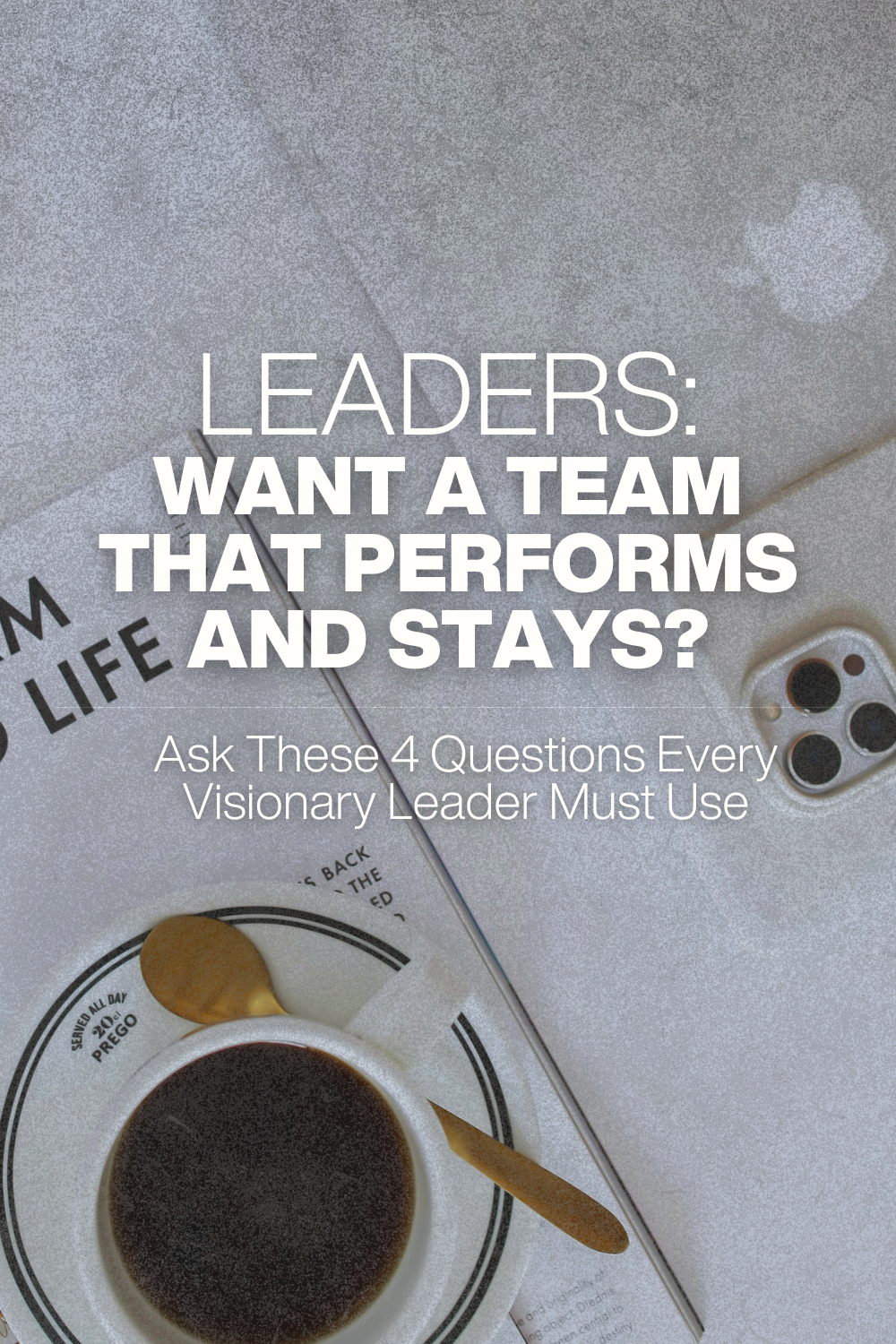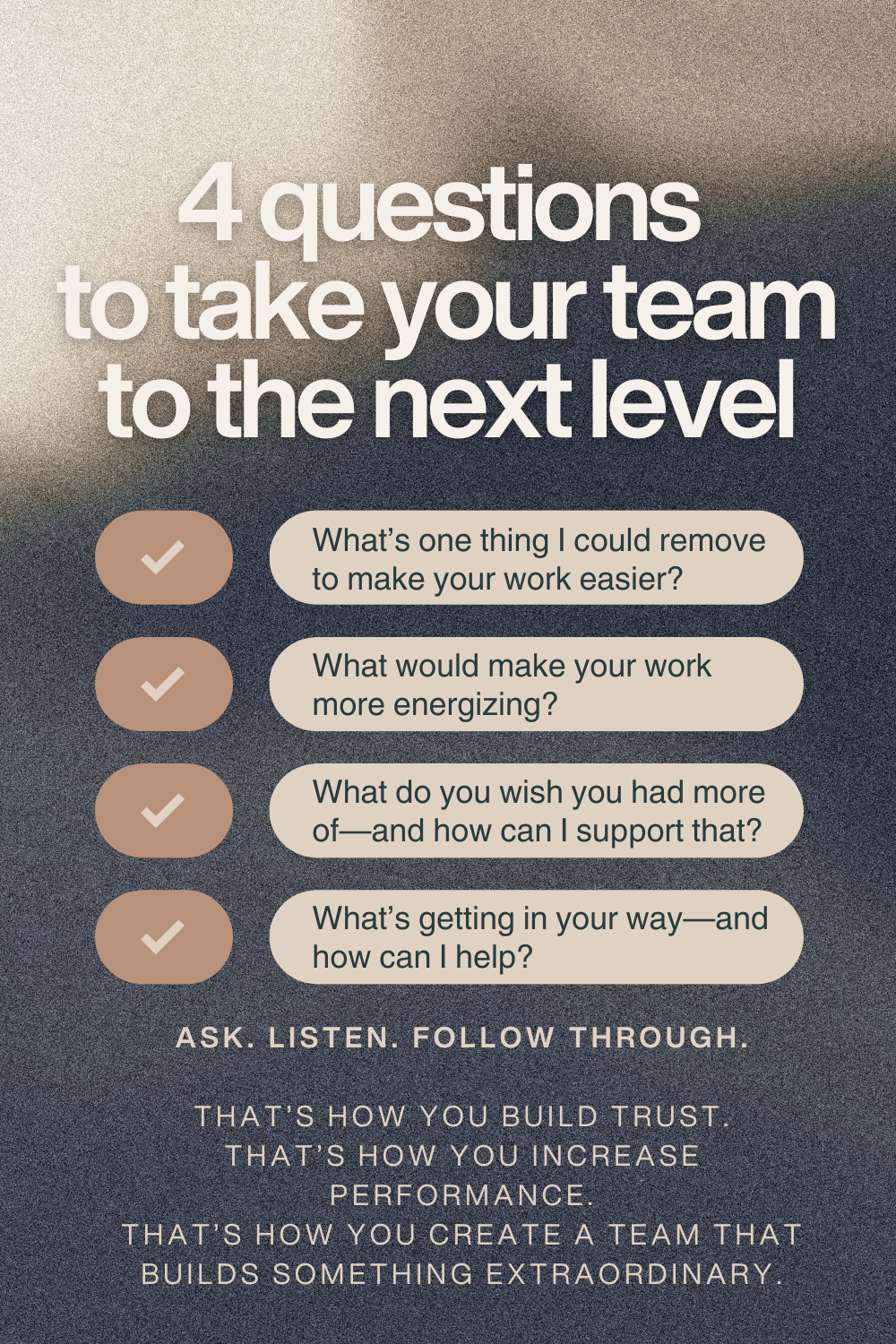
If you care as much about your team as you do your goals, you need to start asking better questions.
Most leaders want to boost productivity, streamline execution, and help their teams thrive—but they often default to asking for more.
More output.
More hours.
More performance.
But great leaders don’t just demand more. They remove what gets in the way.
When it comes to improving team performance quickly and meaningfully, there’s one tactic I return to again and again:
Ask your team the right questions.
Then actually do something with the answers.
These four questions consistently transform teams from "fine" to focused, connected, and energized in a matter of days.
They're simple, but powerful. They speak directly to the day-to-day friction your team is navigating—and they help you remove it.
1. What’s one thing I could fix or remove to make your work easier?
This question is gold for surfacing silent friction.
Often, your team is tolerating inefficiencies, broken systems, or process gaps because they don't want to complain, or they assume nothing will change.
But when you ask this question directly, with genuine intent to act, you create a permission structure.
It tells your team: "Your experience matters. If something’s slowing you down, I want to know about it so we can fix it."
The key is to listen without defensiveness. You may hear things you didn’t know were frustrating (or causing wasted effort). That’s the point.
2. What’s one change that would make your work more energizing?
People don’t just want to be efficient. They want to feel alive in their work.
This question goes beyond productivity into intrinsic motivation. It uncovers how each team member connects to their work emotionally and creatively—which is essential if you're building a visionary, purpose-driven company.
You might hear requests like:
- "More autonomy to structure my day."
- "More creative projects or collaborative sessions."
- "A clearer understanding of how my work connects to the bigger vision."
3. What do you wish you had more of in your role—and how can I support that?
This question reveals hidden ambitions, underused strengths, and opportunities for growth.
It's a gateway to unlocking discretionary effort and building trust.
Sometimes, team members want more leadership opportunities. Sometimes it's mentorship. Sometimes it's something as simple as fewer meetings or more time to think.
This is where visionary leadership really shines: helping people grow inside the system you're building. People will stay longer and perform better when they feel seen and supported.
4. What’s getting in your way right now—and what do you need to move through it?
This is the question that high-performing teams rarely get asked—but desperately need. It goes beyond logistics into mindset, confidence, and emotional load.
It invites vulnerability, and when asked with care, can transform your relationship with your team. They may reveal personal blockers, fears, or internal tensions that are limiting their focus or effectiveness.
It also signals: You're not alone in this. I'm in it with you.
Why This Works: The Psychology Behind Better Questions
Each of these questions is designed to:
- Reduce friction
- Increase psychological safety
- Create alignment between human needs and business goals
Research from Google’s Project Aristotle found that psychological safety was the #1 predictor of high-performing teams.
When you use these questions consistently, you also:
- Build trust through micro-moments of care
- Make space for innovation by clearing distractions
- Increase retention by making people feel valued and heard
You Don’t (Always) Need a Retreat. You Need a Rhythm.
Job Burnout is booming at 66% in 2025.
A lot of companies wait until tension is boiling over to have conversations like these.
Instead, make it part of your operating rhythm.
- Ask 1 question per week in your team meetings.
- Make them part of your 1:1 agenda.
- Add them to onboarding or quarterly check-ins.
The Bottom Line: Your Team Is the Strategy
You don’t need to be a perfect leader.
But if you care about your people, and you show it by asking better questions and acting on the answers—you’re already ahead of most.
Ask. Listen. Follow through.
That’s how you build trust.
That’s how you increase performance.
That’s how you create a team that builds something extraordinary.
10 Steps to Building Successful Employee Engagement
Because businesses with highly engaged teams show 23% greater profitability and 43% less employee turnover. Check it out!
My Unconventional Approach to Aligning Roles with Strengths
Because you might have the right people in the wrong seats… and there’s an easy fix.

Want help designing your team’s high-performance rhythm?
You’re in the right place.
Let’s talk about how to build a system that supports your vision—and your people.
Find me on Instagram, LinkedIn, and X!
Better yet? Book a free call and let’s find your personalized first steps.
Get fresh takes on work-life alignment, leadership, and optimizing quality of life.


Member discussion